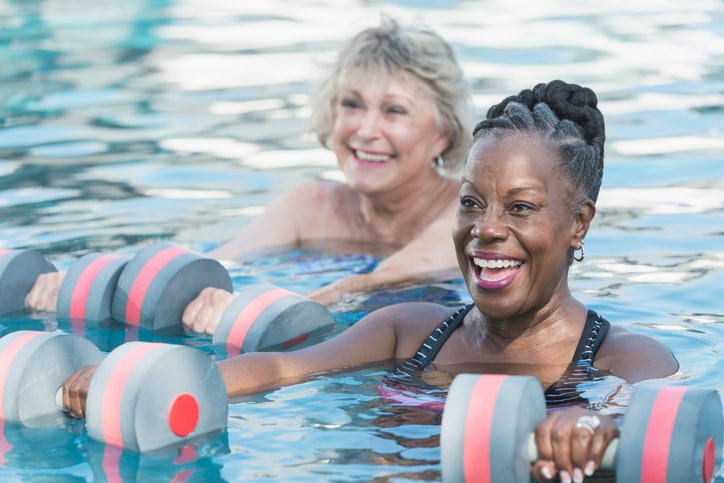In this article
Finding a fitness routine that works for you is tricky at any age, but it can be even more difficult as you get older and your abilities change. You’ll want to find workouts that are engaging and sufficiently challenging, but that don’t trigger any pain or interfere with any health issues.
One accessible option to consider: Water aerobics for seniors, which offers low-impact training that’s easy on the joints and is accessible exercise for all fitness levels, making it a great choice for seniors, says Roy Fowler, a certified personal trainer with the National Academy of Sports Medicine and fitness manager at Stoneridge Creek senior living community in Pleasanton, California.
How do you get started with water aerobics or help a senior in your life jump in? Here’s what experts have to say about swimming exercises for seniors
Key takeaways
- Water aerobics and exercises are ideal for older adults of varying ability levels, as they’re low impact and generally accessible to all fitness levels.
- Research has found that water exercises can improve people’s quality of life, mood, depression, anxiety, tension and help prevent falls.
- Before getting starting with a water exercise routine, be sure to check in with your health care team and attend a class that’s led by a certified professional.
What are the benefits of water exercise for seniors?
Shirley Kaminsky has been doing water aerobics for 20 years, though she’s always loved being in the pool. “I was on the swim team when I was in middle school and just always wanted to stay active in the water,” she says. Now, at 80 years old and a resident of Stoneridge Creek senior living community in Pleasanton, California, Kaminsky does water aerobics three times a week.
“It’s a way to get good cardiac exercise without the damage on the joints,” she adds. “I enjoy the structure of classes, exercising to music, and moving to the beat. It’s very freeing to be in the water. It’s almost as if you can meditate as you’re moving.”
Kaminsky says she has less joint discomfort because of her water aerobics practice and also likes that it’s a social event.
“It’s a way to get good cardiac exercise without the damage on the joints. I enjoy the structure of classes, exercising to music, and moving to the beat. It’s very freeing to be in the water.”
— Shirley Kaminsky
Joy Jones, 89, a resident at Morningside of Fullerton senior community in Southern California, did water aerobics classes at her local LA Fitness for 20 years, up until the COVID pandemic. “The people in the class kept me coming back. I made so many friends and we held each other accountable to keep coming back,” she says. Water aerobics made her notably stronger, she notes. “It was hard work and not easy, but I always felt so good afterward and was energetic.”
Science backs up these benefits of water exercise for seniors. A 2020 review of research on the subject found that water-based exercise can effectively improve people’s quality of life, mood, depression, anxiety, tension, and fall efficacy (the ability to do daily activities without falling).
And a more recent study published in 2021 in the International Journal of Environmental Research and Public Health also found that older adults who completed a 28-week aquatic exercise program showed significant improvements in muscle mass, functional fitness, and cognitive function compared to those who didn’t exercise.
How can older adults get started with water aerobics?
Seniors can do water aerobics on their own, either in the shallow end of a home or public pool, with the help of a written workout plan or a follow-along YouTube video. But the absolute best way to participate is through a class. This not only gets you the supervision of a trained professional, who will make sure you’re exercising safely and effectively, but you’ll also get the camaraderie and social support that Jones mentioned.
(And that’s no small thing. Research shows that, as we age, participating in enjoyable social activities can boost mood, help reduce the risk of certain diseases, lengthen lifespan and improve thinking abilities, according to the National Institute on Aging)
“The best way to start is by choosing an appropriate class to fit your level,” Fowler says. Be sure to read the descriptions to get an idea of what the class will entail and who it’s designed for. Water exercise classes for seniors can be aerobics-, dance-, or yoga-based, designed for specific conditions (like arthritis) or performed entirely in the deep or shallow end of the pool. Some facilities even offer underwater cycling classes, high-intensity interval training or water stretching classes.
Where can I find water aerobics for seniors?
You can find water aerobics classes for seniors at a variety of facilities such as:
- Senior living communities
- YMCAs
- Gyms
- Athletic clubs
- Local recreation centers
- Public pools
Your health insurance may also give you access to fitness programs designed specifically for seniors — and even if it doesn’t, those programs can help you find classes or pool facilities near you.
For example, SilverSneakers is a health and fitness program for adults 65+ that’s included with many Medicare Advantage plans (see if you’re eligible here). On the SilverSneakers website or via their app, you can stream follow-along workout classes, including water aerobics for seniors. They also have a location search feature to help you find SilverSneakers-participating facilities with pools, as well as pool-based community classes nearby. Silver&Fit, another fitness program included in a variety of health plans, including Medicare, offers similar tools and benefits.
There are also plenty of free water workouts on YouTube led by experienced instructors. These workouts use a variety of equipment (including aqua dumbbells, kickboards or pool noodles) or none at all. This can be a great option if you have your own pool and want to start exercising at home.
“Swimming and water exercise programs provide total-body exercise with little to no weight-bearing due to the buoyancy of the water.”
— Chris Gagliardi, medical exercise specialist
Senior water aerobics safety tips to note
In general, water exercise is pretty safe, Fowler says, since it reduces the risk of falling and is gentler on your joints than dry land workouts. “Swimming and water exercise programs provide total-body exercise with little to no weight-bearing due to the buoyancy of the water,” explains Chris Gagliardi, a certified personal trainer and medical exercise specialist with the American Council on Exercise.
This can benefit people who carry more weight or who have joint problems, since the effects of water help offload weight from the hips, knees and ankles, he explains, pointing out that this can be a huge benefit for those who may be limited in the types and amounts of exercise they can perform as a result of joint pain.
That said, there are still some safety factors seniors should keep in mind when trying water exercise:
Check with your doctor first, if necessary
“Immersion in water causes the blood to be redistributed to the central circulation, away from the limbs,” explains Gagliardi. In people with circulation issues (such as heart disease or high blood pressure), this can lead to complications like, breathlessness and added cardiac stress. So if an individual has any circulatory problems or conditions, it’s best to check with their doctor before beginning an exercise program that includes water exercise, he says.
Start slowly and listen to your body
It’s easy to get out of shape over months or years, and often, people try to do too much too fast and get hurt, says Karl Knopf, author of “Make the Pool Your Gym, 2nd Edition” and prior director of the fitness therapy program at Foothill College for almost 40 years. “It’s better to slowly start for 5 to 10 minutes,” he says. “See how you feel the next day and then slowly increase or decrease based on how you felt the day before.”
Consider how deep you want to go
“Make sure you’re comfortable with the depth of the water,” Fowler says. Even if you’re staying in the shallow end, the depth of the water will change how hard you’re working. The energy cost (i.e. effort) of moving through water is related to the depth of the water (think: the difference between walking in thigh-or chest-deep water), Gagliardi explains.
Knopf recommends doing water exercise in chest-deep water, which will be easy on your joints while offering resistance to challenge both your lower and upper body.
Keep an eye on the water temp
“Another important consideration is water temperature and the type of exercise being performed,” Gagliardi says. The Aquatic Exercise Association offers specific recommendations for water temperatures based on the type of activity being performed, the intensity of the exercise, and any specific health conditions a person may be living with. “Water temperatures from 83-86° is most comfortable for a variety of water fitness classes,” he says.
Don’t forget to hydrate
“Sweating is not as obvious when exercising in water,” Gagliardi says, so be sure to maintain proper hydration before, during, and after a water workout.
The National Council on Aging recommends that older adults drink one-third of their body weight in ounces of fluids per day and watch for signs of dehydration like dark-colored urine, headaches or fatigue.
What are the best water exercises for seniors?
The reality is, most workouts done outside of the water can be done in the water, Fowler says. You can bicep curl with pool noodles, do leg lifts or even run in the water.
If you have a pool and want to try water aerobics at home — or you just want a better idea of what a water aerobics class may entail — check out this list below. (And for more ideas, instructions, and comprehensive workout plans Knopf also recommends checking out his book, which offers programs for chronic conditions, beginners and advanced individuals.)
1. Water walking
This entry-level move recommended by Fowler and Knopf is simple and one that seniors can definitely try on their own: walking back and forth in the water. In addition to moving forward, you can walk backward, sideways, and do a monster walk (i.e. feet wide) to vary the movement pattern and muscles worked. You can also try skipping or shuffling your feet back and forth (as if you were cross-country skiing).
2. Jumping jacks
“Basically, water exercise is doing land exercises in the pool, so anything you would do on land can easily be adapted to the water such as jogging or jumping jacks,” says Knopf.
Plyometric (jumping) moves like jumping jacks, high knees, and butt kickers are high-impact on land, but low-impact in the water. Try doing any of them in the shallow end of a pool, and you’ll be surprised how difficult they are.
To do a jumping jack, start with your feet together and arms by your sides. Simultaneously hop your feet apart and lift your arms out to the sides up to shoulder height. Reverse the movement to return to the starting position.
3. High knees or marches
A simple marching motion or high knees will feel tougher (but low-impact) in the pool, thanks to the resistance offered by the water. This move will work your core, hip flexors, and legs and get your heart pumping.
Stand with your feet together and, one at a time, lift your leg up until your knee is at about hip height, knee bent at 90 degrees. Allow the opposite arm to come forward slightly as if you were running. Then repeat on the other side and continue alternating. Start slow, and speed up to make it harder: Moving quickly in the water will help raise your heart rate, Fowler says.
4. Butt kickers
Because you have to push through the water, a simple butt kicker turns into a water-resisted hamstring curl when done in the pool. Stand with your feet hip-width apart and arms by your sides or clasped in front of your chest. One at a time, kick your heels up to meet your butt.
5. Flys
To get the benefits of the water’s resistance, Dr. Knopf strongly suggests keeping your arms underwater for upper-body exercises.
Try flys: Stand in the shallow end with your arms underwater and extended out to the sides. Keep your hands open, palms facing forward and your arms extended with a soft bend in the elbows. Push your arms through the water until they come together in front of your chest (almost like you’re trying to clap your hands together). Then, reverse the motion, pushing your arms backward through the water until they’re extended out to the sides. You should feel your chest and back muscles working.
6. Curl and press
Floating aquatic dumbbells can add a challenge when strength training in the pool, and can be used for both the lower and upper body, Fowler says. But many moves done with aqua dumbbells can also be done with just your body, like biceps curls and overhead presses.
To try the move, stand in shoulder-height water with your arms by your sides, hands open and palms facing forward. Push through the water to curl your hands up toward your shoulders. When they reach your shoulders, turn your palms to face up, and press your arms overhead. Reverse the movement to return to the starting position.
7. Upright rows
This move can be made harder by holding onto aqua dumbbells or a pool noodle, though you’ll also feel it with just your body weight. Stand with your feet hip-width apart and knees slightly bent. With your hands in fists, lift your elbows up and out to the sides so they’re at shoulder height, your arms bent so your fists are in front of your shoulders, under the water. Push your fists down in front of your body until your arms are straight, then pull them back up to return to the starting position.
If trying these moves on your own feels daunting, don’t hesitate to find a class with a knowledgeable instructor who can guide you through it all. You could come away with a new favorite workout, not to mention a sense of community, a stronger body, and a fresher mind. “Anyone can participate no matter the skill set,” encourages Fowler. “My best advice is to just try it.”





